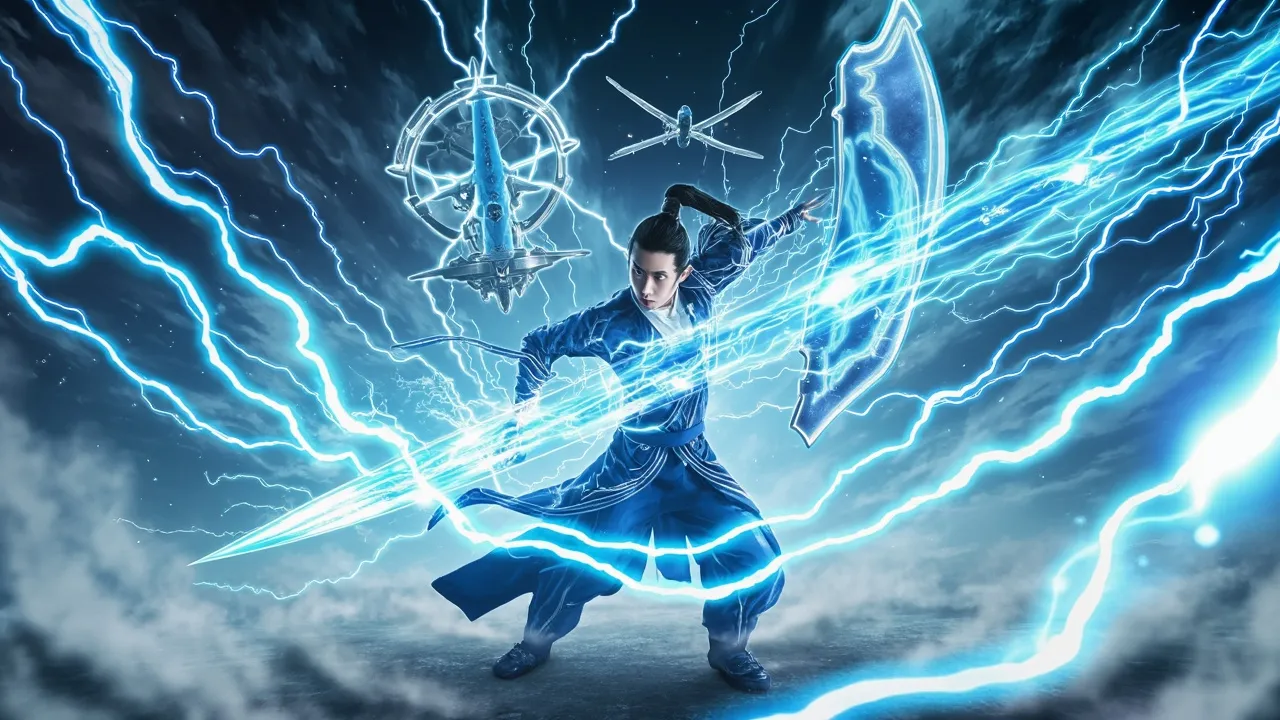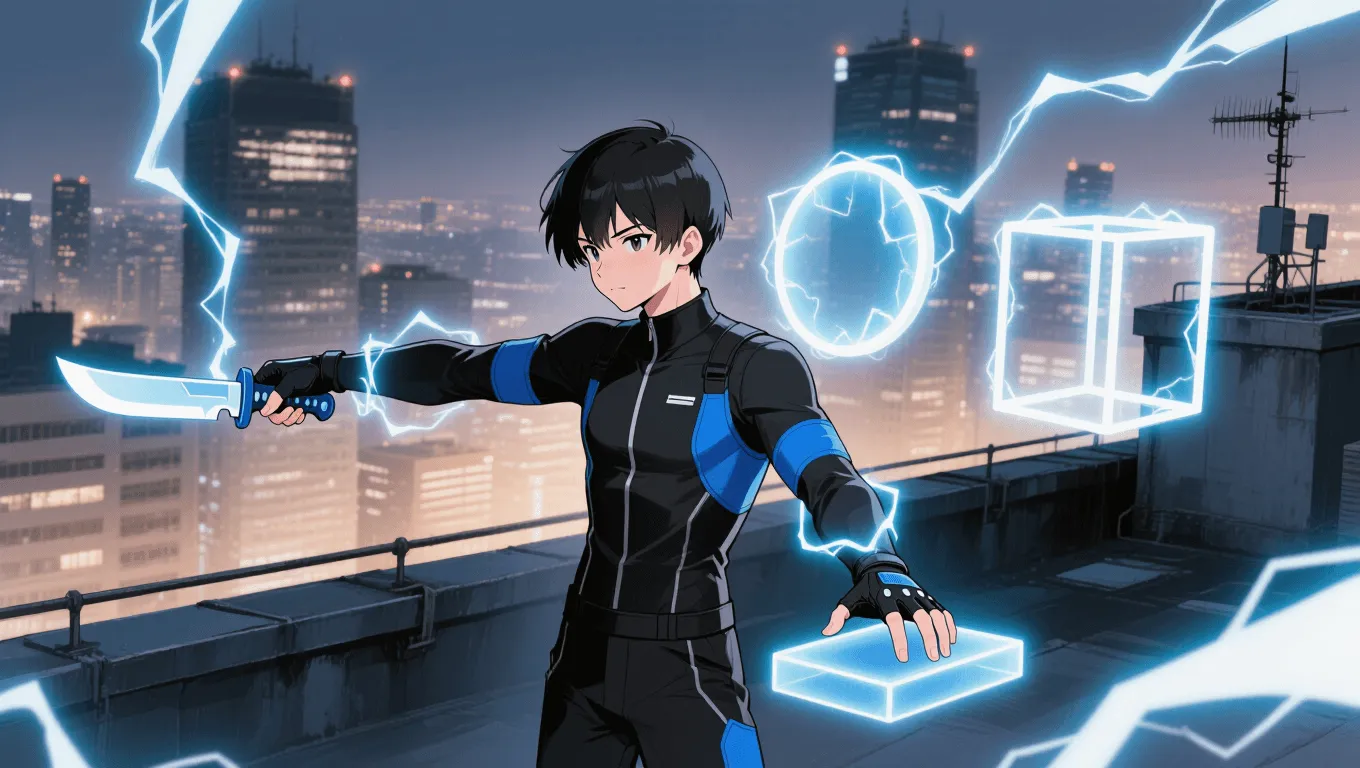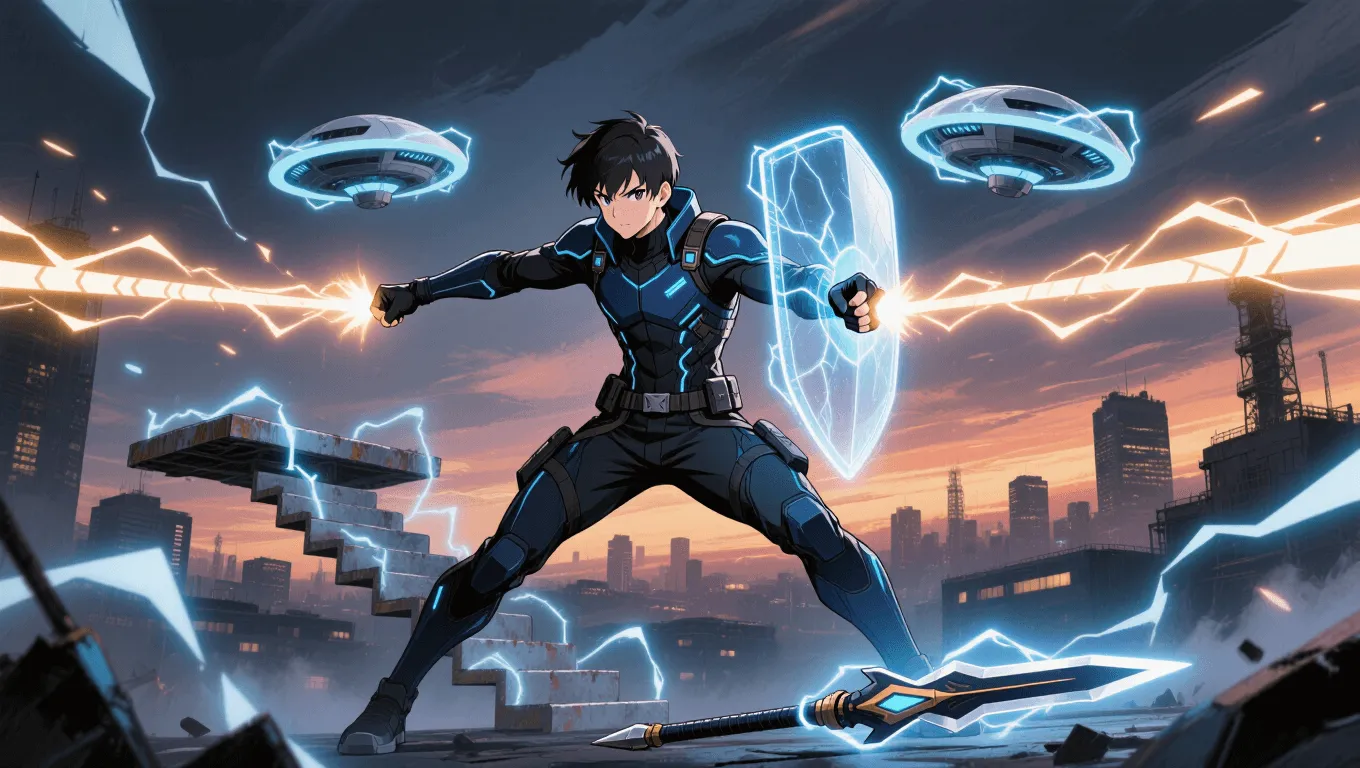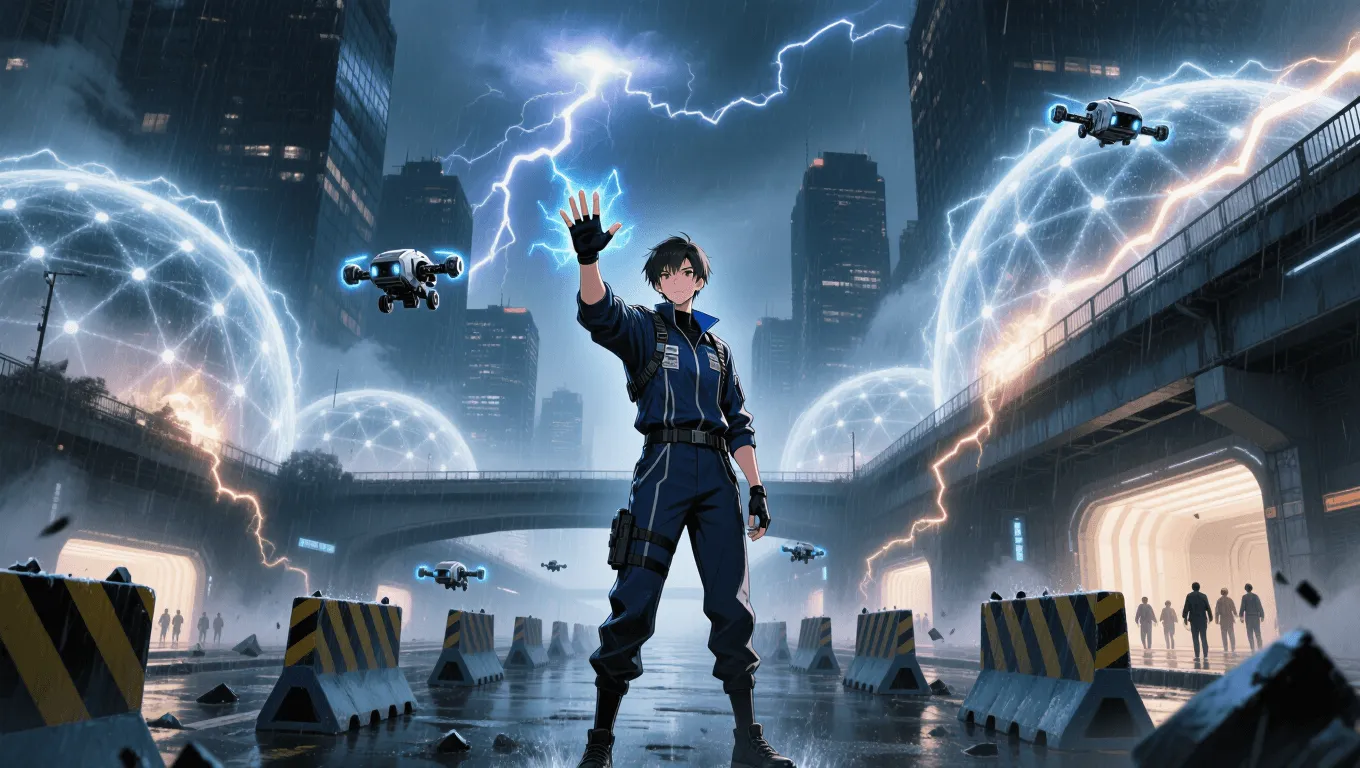Electrokinetic Constructs: The Power to Shape Lightning

Electrokinetic Constructs Video Demo 🎬
Table of Contents
- Electrokinetic Constructs Video Demo 🎬
- What Is Electrokinetic Constructs
- Core Abilities of Electrokinetic Constructs
- Application / Tactical Advantages in Combat
- Level: Level 1 🏙️, Level 2 🌇, Level 3 🌃
- Limitations of Using the Electrokinetic Constructs
- Weakness Against What Other Superpowers
- Synergistic Power Combos
- Known Users
Electrokinetic Constructs is the superpower to shape raw electricity—guided by electromagnetic fields—into stable, functional forms. Instead of unleashing only bolts or arcs, a wielder sculpts charge into tangible “objects” such as blades, shields, cages, platforms, drones, or even intricate tools. By precisely controlling voltage, current, and field geometry, these electric constructs behave like hard-light energy models: coherent enough to cut, block, or carry weight, yet agile enough to reconfigure in a blink. This entry explains how the power works, where it shines in combat, how it levels up, and how it interacts with other abilities. For a broader context, explore the growing catalog in our superpower wiki or try a new ability at random with our random superpower generator.
What Is Electrokinetic Constructs
Electrokinetic Constructs belongs to the family of electrokinetic manipulation powers, bridging energy projection with precision field-shaping. The user creates ionized “skins” and electromagnetic scaffolds that corral free electrons, turning intangible lightning into semi-solid geometry—a spear that pierces, a buckler that absorbs, a lattice that traps. Unlike standard electric discharge, the emphasis is on control and cohesion. The strongest practitioners can phase between conductive and insulating states, allowing constructs to carry, push, and even isolate targets safely (or dangerously).
Common related terms and techniques include electric field manipulation, electromagnetic barrier generation, plasma shaping, charge cohesion, Faraday cage formation, and lightning architecture.
Core Abilities of Electrokinetic Constructs
Shaped Weapons
-
Electro-blades and spears: Edge-stable constructs with variable length and density. High-frequency edge modulation increases cutting power while minimizing collateral arcs.
-
Arc whips and chains: Flexible, extendable, and ideal for disarming or ensnaring. Conductive mode can stun; insulated mode can bind without shocking.
-
Voltage gauntlets: Reinforced knuckles and forearm bracers that dissipate impact shock into the target while protecting the user’s joints.
Defensive Barriers
-
EM shields and domes: Curved field geometries distribute incoming force and can shunt charge around the bearer (Faraday effect). Tuning the impedance lets the user block projectiles, dampen blasts, or deflect heat.
-
Containment cages: Box or sphere constructs that keep threats inside by cycling polarity and ion density—effective for non-lethal captures.
Utility Constructs
-
Platforms and bridges: Load-bearing “floors” stabilized by layered fields. Short spans can support body weight; advanced users create multi-person ramps.
-
Tools and keys: Momentary lockpicks, cutters, welding arcs, or micro-manipulators for delicate tasks (e.g., defusing devices by fusing a single trace).
-
Spotlights and signage: Visible, humming edges that illuminate dark zones or provide visual cues during operations.
Remote Constructs and Drones
-
Charge-drones: Palm-sized constructs that scout, relay signals, or act as mobile tasers.
-
Tethered sentry grids: Stationary lattices that sense motion via field disturbance and auto-stun intruders.
Scale & Complexity
- Micro to macro: From hairline needles of current for surgery-like precision to arena-sized domes for crowd protection. Complexity grows with topology—smooth forms are easier; articulated, jointed geometry is advanced.
Precision & Control
-
Programmable behavior: Patterns can be “scripted” by oscillating fields—e.g., a shield that opens only when friendlies approach, or a whip that coils on command.
-
Selective conductivity: Switching between conductive and insulating modes enables non-lethal grapples, safe lifts, or surgical burns on target-only surfaces.
Application / Tactical Advantages in Combat
-
Instant arsenal: The user carries no gear yet can summon blades, shields, and restraints at will. This slashes loadout complexity and adapts to changing threats.
-
Area denial and zoning: Grids, fences, or low-lying “tripwires” compel enemy movement. Insulated versions corral without harm; conductive versions deter pursuit.
-
Non-lethal dominance: Tasers, binders, and cages prioritize compliance over injury. Adjustable amperage customizes force for crowds, armored targets, or augmented foes.
-
Active defense: EM shields dissipate kinetic energy and disperse thermal loads. With the right tuning, even shrapnel fields can be “bent” around friendlies.
-
Mobility boosts: Step platforms, rail slides, or “elevators” mitigate terrain disadvantages and enable vertical flanking or emergency evacuation.
-
Counter-tech options: Brief EM pulses disrupt optics, sensors, or smart munitions. Targeted interference can desync drones or scramble aim-assist.
-
Environmental synergy: Conductive surfaces (wet ground, metal structures) amplify reach; insulation zones (rubber mats, dry sand) contain spread.
Level: Level 1 🏙️, Level 2 🌇, Level 3 🌃
Level 1 🏙️ — Spark Sculptor

Profile: Initiates who can hold shape for a few seconds.
Typical Constructs: Short knives, bucklers, simple cages, single-step platforms.
Range & Duration: Arm’s length; seconds of cohesion before dissipating.
Focus Areas:
-
Basic field geometry (arcs, discs, rods).
-
Safety fundamentals: amperage control, avoiding unintended conduction.
-
Non-lethal output: stun-only settings, insulated binds.
Risks: Overheating, shorting through wet clothing, reflex arcs causing accidental discharge.
Level 2 🌇 — Arc Artisan

Profile: Trained users able to maintain multiple constructs simultaneously with scripted behavior.
Typical Constructs: Whips, segmented shields, two-platform staircases, drone pairs, reinforced spears.
Range & Duration: Room-scale; up to a few minutes per construct with intermittent refresh.
Focus Areas:
-
Multi-construct management (offense + defense).
-
Selective conductivity and insulation layers for crowd control.
-
Tactical EM interference against sensors and drones.
Risks: Cognitive load from multi-object control; collateral effects near sensitive electronics; fatigue from sustained field maintenance.
Level 3 🌃 — Storm Architect

Profile: Elite practitioners who design complex, load-bearing, and adaptive architectures.
Typical Constructs: City-block domes, dynamic bridges, autonomous charge-drones, kinetic-dispersing barricades.
Range & Duration: Street to district scale; persistent fields with minimal upkeep thanks to efficient resonance patterns.
Focus Areas:
-
Adaptive constructs that “listen” to impacts and retune impedance on-the-fly.
-
Macro-scale evacuations and disaster response (bridges, shields, lighting).
-
Integration with broader electromagnetic phenomena (ionized fog, lightning recall).
Risks: Massive energy draw, weather interference, and high-profile EM signatures that attract countermeasures.
Limitations of Using the Electrokinetic Constructs
-
Energy Budget: Constructs require continuous field reinforcement. Long fights deplete bioelectric reserves or external power sources.
-
Conductive Surfaces: Metal and water can redirect or dilute the construct’s edge, reducing control or spreading shock unintentionally.
-
Insulation Barriers: Rubberized suits, ceramic armor, and dry sand zones resist penetration, forcing brute-force approaches or alternate tactics.
-
Line-of-Sight Complexity: Intricate shapes behind obstacles are harder to stabilize; diffraction and attenuation dampen control.
-
Electromagnetic Noise: Heavy industrial sites or jamming powers can disrupt fine control and cause constructs to “fuzz.”
-
Thermal Load: Prolonged constructs generate heat; users must avoid burns or air ignition when operating at high amperage.
-
Precision Demands: Fine work (surgery, microelectronics) risks collateral arcs without meticulous modulation.
-
Compliance & Ethics: Non-lethal intention can fail if conductivity surges; strict amplitude caps and training protocols are essential.
Weakness Against What Other Superpowers
-
Insulation & Earth Manipulation: Earthen ramparts, ceramic walls, or sand coffers soak or block charge, blunting electric weapons and caging attempts.
-
Hydrokinesis (Controlled): Skilled water users can diffuse, divert, or short constructs, especially with ion-rich solutions.
-
Electromagnetic Nullification: Field dampeners or energy-negation powers collapse cohesion, turning constructs into harmless static.
-
Magnetokinesis: Magnetic shearing and field warping deform constructs, causing edges to ripple or collapse.
-
Energy Absorption: Electric absorbers drain constructs on contact, depriving the user of both weapons and shields.
-
Vibration/Sonic Manipulation: Resonant interference destabilizes field harmonics, making shapes brittle or noisy.
-
Light/Heat Overwhelm: Thermal lances and solar flares can force overcooling or overheat cycles, distracting the user with thermal management.
Synergistic Power Combos
-
Weather Control: Ambient lightning supply reduces energy cost and boosts construct intensity; stormcloud ionization improves cohesion.
-
Technopathy: On-the-fly calibration for drones, sensors, and shields; constructs sync with tactical HUDs for “smart” shape shifting.
-
Kinetic Dampening: Pairing with impact-nullifying fields yields near-impenetrable barricades and safe high-speed intercepts.
-
Telekinesis: Offers independent stabilization, letting constructs hold shape at extreme range or behind cover.
-
Cryokinesis: Flash-chilling ionized air around constructs can “harden” edges and temper thermal load.
-
Magnetism (Allied): Friendly magnetic fields can refine edge stability, creating razor-thin, low-energy blades and ultra-rigid shields.
-
Bioelectricity: Users who generate surplus bioelectric power can sustain more constructs, longer, with finer control.
Known Users
-
Static (Virgil Hawkins): A teen hero famous for electromagnetic manipulation, capable of discs, cages, and field-based constructs. (See more on Static at Wikipedia)
-
Livewire (DC Comics): Often depicted shaping electricity into lashes and barriers, mixing raw discharge with field tricks.
-
Cole MacGrath (inFAMOUS): A video game icon who weaponizes electricity with growing precision and creative construct use.
-
Original Characters in Tabletop & Webcomics: Many settings explore electric shields, taser chains, and rail platforms as character signatures.
SEO Notes & Related Keywords:
Electrokinetic Constructs, electric constructs, electromagnetic barrier, plasma shaping, electric field manipulation, lightning weapons, energy shields, Faraday cage, non-lethal stun, charge cohesion. For more power profiles and cross-ability strategies, browse the superpower wiki or spark inspiration with the random superpower generator.
